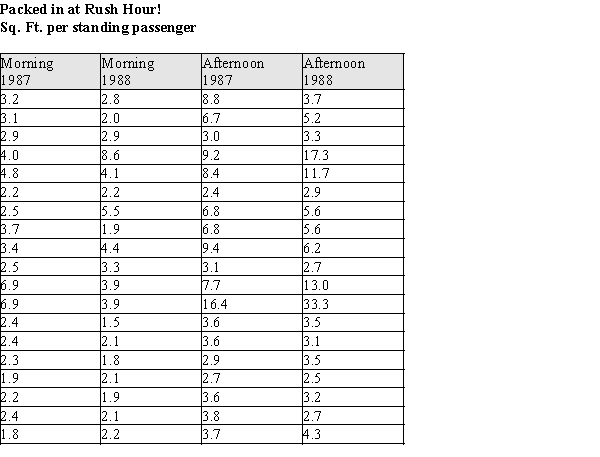Exhibit 3-2
In 1990 the New York Times reported the average number of square feet per standing passenger in 1987 and 1988 for 19 subway stops. Although the sampling method was not reported, we will presume that these data represent a random sample of days during the morning and evening rush hours. The NYC Transit Authority managers attempted to improve the space problem on subway cars (more space is better--trust us!) by adding cars to trains during the rush hours. They gathered the 1988 data to check on their efforts after one year. The data are in the table below. 
-Refer to Exhibit 3-2.
(a)Construct a comparative stem & leaf plot of the space per standing passenger for the morning rushes of 1987 vs. the morning rushes of 1988.
(b)Using your plot in part (a), describe the differences and similarities in the distributions of the morning standing room for the two years.
Definitions:
Behavioral Therapy
A type of psychotherapy that aims to modify harmful behaviors through conditioning and learning strategies.
Attention-Deficit/Hyperactivity Disorder
A neurodevelopmental disorder characterized by patterns of inattention and/or hyperactivity-impulsivity that interfere with functioning or development.
Behavioral Therapies
Psychotherapeutic approaches that focus on identifying the reinforcements and punishments contributing to a person’s maladaptive behaviors and on changing specific behaviors.
Pervasive Developmental Disorders
Disorders characterized by severe and persisting impairment in several areas of development.
Q2: Let <img src="https://d2lvgg3v3hfg70.cloudfront.net/TB7677/.jpg" alt="Let represent
Q7: A statistic is a characteristic of the
Q9: The owners of the Burger Emporium are
Q10: The data below were gathered on a
Q18: Suppose that a particular candidate for public
Q32: A large cable company reports that 70%
Q34: The marketing concept stresses that a business
Q37: A study is commissioned to determine whether
Q46: One of the tasks of wildlife biologists
Q162: An investment opportunity advertises as follows: invest